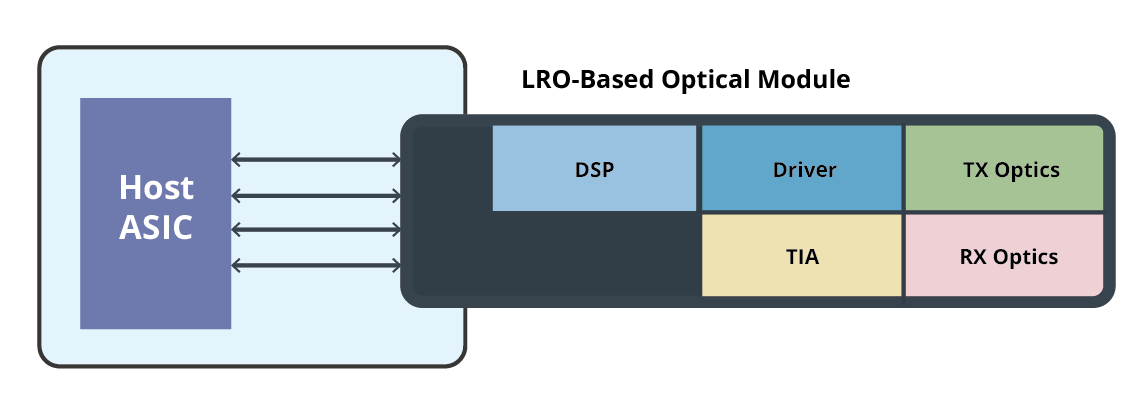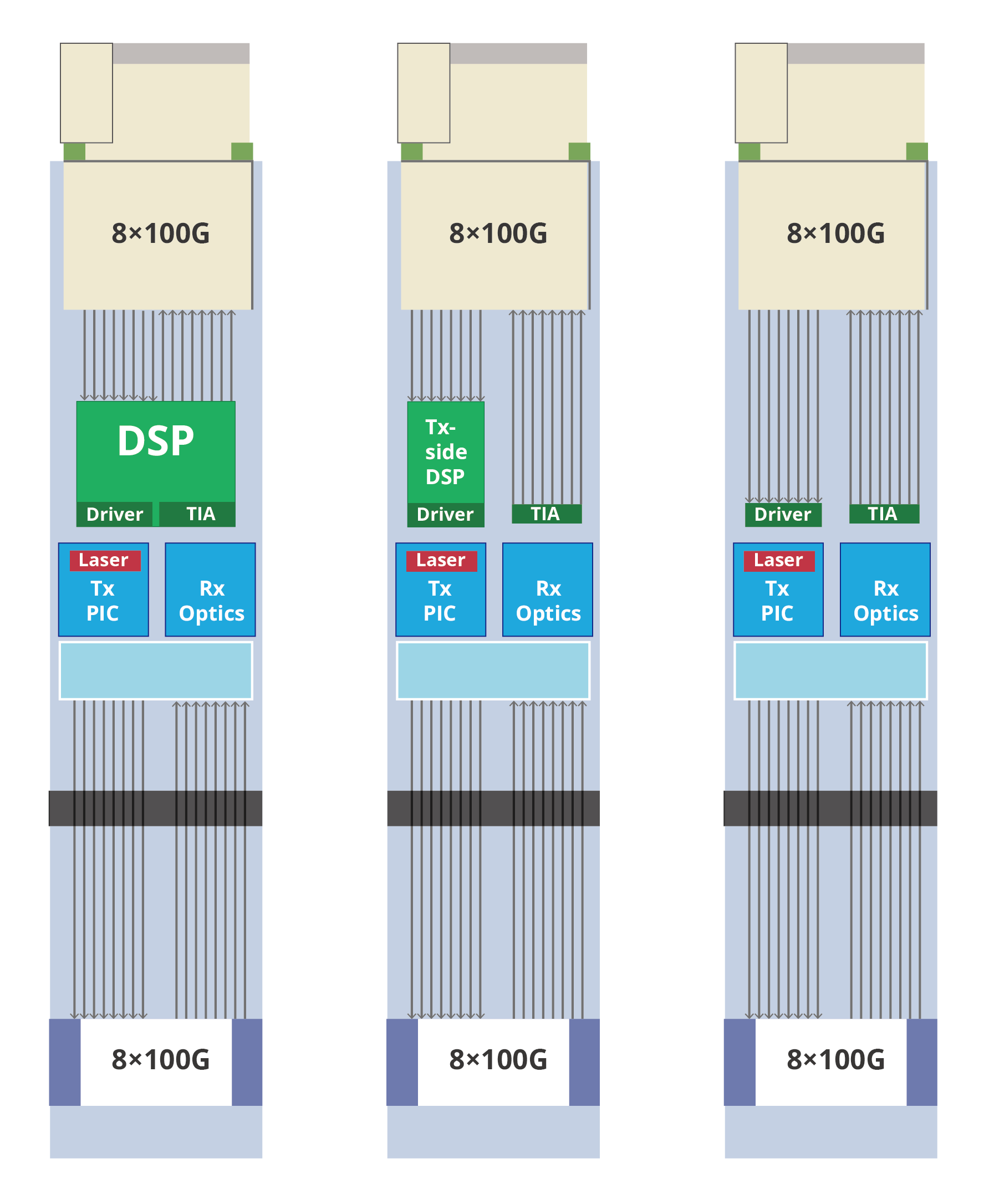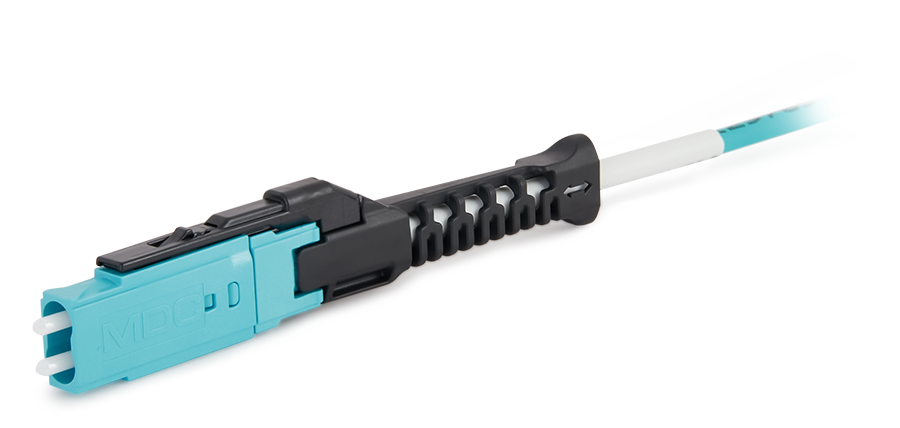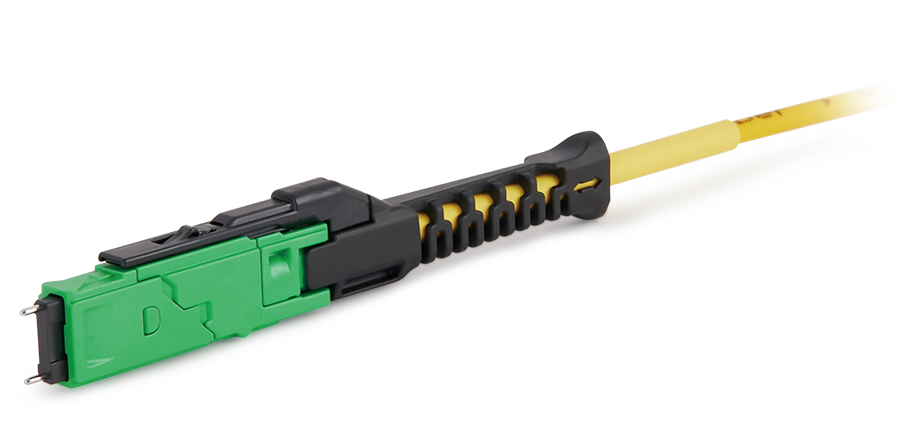1. Introduction: The “Power Bottleneck” in AI Networks
Today’s data center landscape is undergoing a profound transformation. The explosive growth of AI workloads, the rapid expansion of cloud-scale computing, and the transition from 800G toward 1.6T interconnect technologies are fundamentally reshaping the balance between performance, cost, and energy efficiency.
Amid this shift, optical transceiver technologies—particularly those based on Digital Signal Processors (DSP) and Linear-Drive Pluggable Optics (LPO)—have emerged as key enablers of next-generation network architectures.
As hyperscale operators such as Meta, NVIDIA, and Google push AI cluster designs toward higher density and faster throughput, power consumption has become a defining bottleneck to scalability. DSP-based optical modules deliver stable long-reach transmission and robust signal correction, but their digital processing incurs higher power usage and added latency.
In contrast, LPO technology, with its streamlined architecture that offloads signal processing to the host ASIC’s SerDes, offers significant advantages in energy efficiency, system simplicity, and cost reduction.
Network architects now face a pivotal design question: which optical approach—DSP or LPO—best aligns with the evolving requirements of AI-driven data centers?
2. Understanding DSP-Based Optical Transceivers
For decades, DSP-based transceivers have served as the foundation of high-speed optical communications. These modules incorporate powerful digital processors that perform advanced signal conditioning, Forward Error Correction (FEC), equalization, and clock recovery.
In a typical DSP-enabled design, the processor compensates for impairments such as chromatic dispersion, fiber nonlinearity, and electrical noise. This capability allows for longer transmission distances (often beyond 10 km) and ensures interoperability across multi-vendor ecosystems.

However, this performance comes at a price. At 800G data rates, each DSP port consumes 12–16 watts, while the additional digital processing introduces several nanoseconds of latency. For AI and ML cluster environments where thousands of GPUs exchange data simultaneously, this latency and power overhead can limit overall scalability.
Key Characteristics of DSP-Based Optics
Advanced equalization and FEC enable robust signal integrity in complex transmission environments
High interoperability and long reach, suitable for telecom and long-haul applications
Higher latency and power consumption, challenging for power-sensitive AI deployments
Ideal for WAN and carrier-grade networks requiring long-distance, multi-vendor compatibility
3. What Is LPO (Linear-Drive Pluggable Optics)?
Linear-Drive Pluggable Optics (LPO) represents a new class of transceivers optimized for power efficiency and minimal latency. Unlike DSP-based optics, LPO modules eliminate the digital signal processor, relying instead on host ASICs or switch SerDes for equalization and calibration.

By removing the DSP, LPO reduces power consumption by 40–50% and lowers latency by several nanoseconds. This simplicity, however, introduces a calibration challenge—LPO requires precise end-to-end tuning between the host and the module.
To address this, the LPO Multi-Source Agreement (MSA) initiative is working to define standard electrical and optical interface specifications, ensuring interoperability across vendors.
Advantages of LPO
Ultra-low power consumption—5–8 watts at 800G, cutting energy use nearly in half
Reduced latency and heat generation, improving thermal design and cooling efficiency
Support for higher port density, enabling compact, high-bandwidth interconnects
Simplified design, with fewer active components and lower failure risks
Today, LPO is rapidly gaining traction in AI and ML clusters—environments where every watt and nanosecond matters. Industry leaders such as Broadcom, Arista, and NVIDIA are actively developing LPO-compatible platforms, primarily optimized for short-reach applications (≤2 km).
At T&S, we view LPO as a transformative step toward building sustainable, high-performance optical infrastructure tailored to next-generation AI data centers.
4. LRO: A Transitional Solution Between DSP and LPO
Linear Receive Optics (LRO) serves as a bridge between DSP and LPO designs. It removes the DSP on the receive end while retaining limited retiming or equalization functions on the transmit side.


Architectures of DSP (fully retimed) module (left), LRO module (center), LPO module (right).
This hybrid configuration offers a compromise between cost, power, and interoperability—making it an effective transitional solution for networks evolving toward fully linear optics or Co-Packaged Optics (CPO).
5. Technical Comparison: DSP, LPO, and LRO
| Feature | DSP-Based Optics | LPO(Linear-Drive) | LRO(Linear-Receive)
|
| Singnal Processing | Full FEC and equalization via DSP | Handled by host SerDes | Partial(Tx or Rx only) |
| Power Consumption(800G) | 12-16 W | 5-8 W | 8-10 W |
| Latency | ~10+ ns | <3 ns | ~6 ns |
| Transmission Distance | Up to 10 km | ≤2 km | 2-5 km |
| Cost | Higher | Lower | Moderate |
| Calibration | Plug-and-play | Requires Calibration | Limited Calibration |
| Target Use Cases | Long-hual, WAN | AI/ML Clusters | Mid-range Connectivity |
6. Why LPO Is Gaining Momentum
AI-driven architectures are reshaping networks toward ultra-dense, short-reach optical connectivity. Each GPU node can generate terabits of bidirectional traffic, making energy efficiency a decisive design factor.
According to LightCounting, over 60% of next-generation AI infrastructures are expected to adopt linear or near-linear optics by 2027. LPO’s quantifiable advantages include:
40% lower power consumption than DSP-based solutions
2–3× higher density per rack unit
Reduced cost per bit via simplified design and manufacturing
These benefits make LPO ideal for Top-of-Rack (ToR) and leaf-spine interconnects—scenarios where distances are short, predictable, and easily managed.
7. Challenges in LPO Deployment
Despite its clear advantages, LPO is not yet a universal replacement for DSP-based optics. Without onboard DSP processing, LPO performance depends heavily on host-side calibration, signal linearity, and SerDes quality.
To ensure interoperability, the LPO MSA consortium—comprising major switch, ASIC, and optical vendors—is defining standard link training and calibration protocols. Until these standards fully mature, LPO deployment requires strict control of optical budgets, thermal conditions, and link parameters.
As a result, LPO currently performs best in homogeneous environments, such as AI cabinets or hyperscale clusters with well-controlled link characteristics.
8. In-Depth Analysis: Power, Latency, and Thermal Management
In high-density racks, small per-port power savings scale to enormous system-level benefits. A network with 10,000 800G links can save roughly 70 kilowatts of power by using LPO instead of DSP optics—equivalent to the energy consumption of hundreds of servers.
Lower heat output simplifies cooling design and enhances long-term reliability. Meanwhile, latency improvements—reducing from ~10 ns to under 3 ns per hop—translate into measurable performance gains in distributed AI training workloads where microseconds matter.
At T&S, our R&D continues to focus on optimizing optical transceiver efficiency, ensuring that energy and thermal improvements translate directly into enhanced network throughput and sustainability.
9. Future Outlook: From LPO to Co-Packaged Optics (CPO)
LPO not only addresses today’s energy and latency challenges but also lays the foundation for future integration with Co-Packaged Optics (CPO) and on-chip SerDes designs.
As IEEE 802.3df and 802.3dj standards advance toward 1.6T Ethernet, the electrical-optical boundary will continue to blur. The success of LPO will depend on ongoing collaboration between switch ASIC vendors, optical module manufacturers, and standardization bodies.
T&S actively supports this ecosystem evolution, leveraging our optical manufacturing expertise to enable scalable, power-optimized solutions for the next generation of high-speed connectivity.
10. Quick Summary: DSP vs. LPO vs. LRO
| Metric | DSP | LPO | LRO |
| Energy Efficiency | ○○ | ○○○○○ | ○○○ |
| Latency | ○○ | ○○○○○ | ○○○ |
| Transmission Distance | ○○○○○ | ○○ | ○○○ |
| Integration Complexity | Low | High | Moderate |
| AI Suitability | Moderate | High | Moderate |
11. Frequently Asked Questions (FAQ)
What is the main difference between DSP and LPO transceivers?
DSP-based optics use digital processing for FEC and equalization, while LPO offloads these functions to the host ASIC’s SerDes, reducing power and latency.
Can LPO fully replace DSP in data centers?
Not yet. LPO excels in short-reach AI and HPC environments, whereas DSP optics remain vital for long-haul and heterogeneous networks.
How much power does LPO save compared to DSP optics?
LPO typically reduces module power consumption by 40–50%, translating into large-scale energy savings in hyperscale deployments.
What is the role of the LPO MSA?
The LPO MSA defines interface standards to improve interoperability, calibration consistency, and cross-vendor plug-and-play functionality.
12. Conclusion: Building the Future of Optical Connectivity
The choice between DSP and LPO is not binary—it’s about selecting the right balance for each application. DSP-based optics remain indispensable for long-haul and multi-vendor environments, while LPO delivers the power efficiency and latency performance demanded by AI and HPC architectures.
As the industry advances toward 1.6T and Co-Packaged Optics, hybrid deployments will become the mainstream. With IEEE and MSA organizations driving standardization, LPO stands poised to redefine data center optical interconnects—enabling faster, cooler, and more sustainable networks for the AI era.
At T&S, we are committed to advancing optical interconnect technologies that bridge performance and efficiency—empowering the data centers of tomorrow.

 Fiber Optic Flex Circuit (FOFC)
Advanced Simulation & Optimization, High Positioning Accuracy, Flexible Customization, Rigorous Reliability Testing
Fiber Optic Flex Circuit (FOFC)
Advanced Simulation & Optimization, High Positioning Accuracy, Flexible Customization, Rigorous Reliability Testing MDC Solution
US Conec's MDC connector is a Very Small Form Factor (VSFF) duplex optical connector, expertly designed for terminating single-mode and multimode fiber cables with diameters up to 2.0mm.
MDC Solution
US Conec's MDC connector is a Very Small Form Factor (VSFF) duplex optical connector, expertly designed for terminating single-mode and multimode fiber cables with diameters up to 2.0mm. MMC Solution
US Conec's Very Small Form Factor (VSFF) multi-fiber optical connector that redefines high-density connectivity with its cutting-edge TMT ferrule technology and intuitive Direct-Conec™ push-pull boot design.
MMC Solution
US Conec's Very Small Form Factor (VSFF) multi-fiber optical connector that redefines high-density connectivity with its cutting-edge TMT ferrule technology and intuitive Direct-Conec™ push-pull boot design. EN
EN
 jp
jp  fr
fr  es
es  it
it  ru
ru  pt
pt  ar
ar  el
el  nl
nl 






_and_High-Reflection_(HR)_Optical_Coatings.webp)
